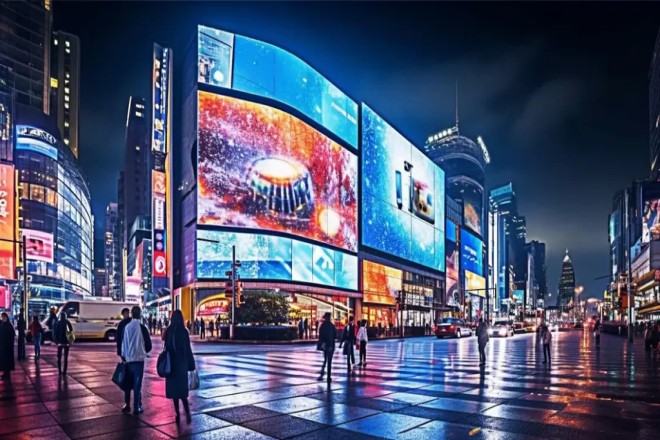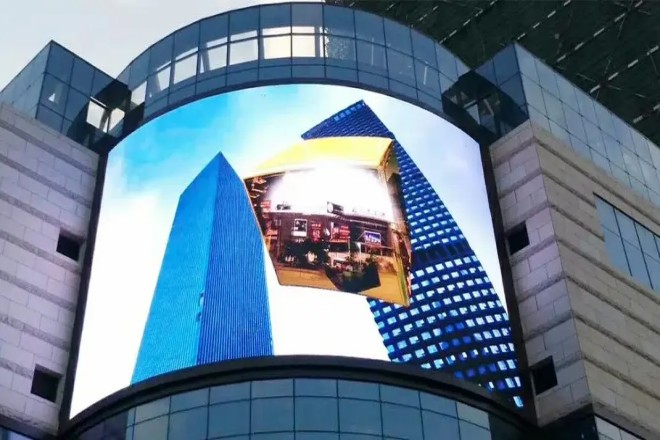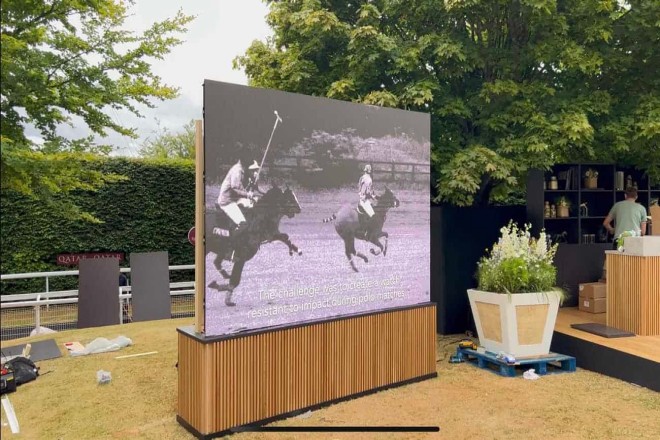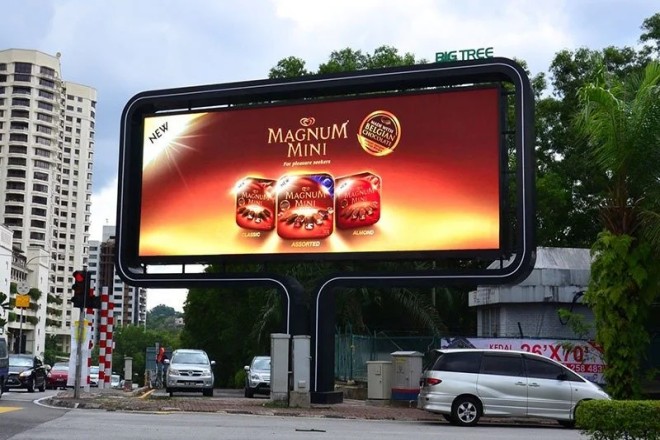소개

디지털 마케팅 시대에 LED 디스플레이 고객을 유치하고 정보를 전달하는 데 중요한 도구가 되었습니다. 그러나 모든 LED 디스플레이 마케팅 전략이 원하는 결과를 달성할 수 있는 것은 아닙니다.
이 글에서는 기업이 이런 실수를 피하고 이 기술을 더 효과적으로 사용할 수 있도록 돕기 위해, 일반적인 LED 디스플레이 마케팅에 대한 몇 가지 오해를 소개합니다.
1. 콘텐츠와 LED 디스플레이의 호환성을 무시하세요

LED 디스플레이의 콘텐츠와 화면 사이에 적응 문제가 있을 때, 아름다움이 크게 감소하고, 심지어 사람을 지저분하게 보이게 하고 아름다움에 영향을 미칠 수도 있습니다. 다음으로, 두 가지 일반적인 적응 문제와 이를 교묘하게 해결하는 방법에 대해 이야기해 보겠습니다.
1) 내용의 왜곡
LED 디스플레이를 위한 시각적 마케팅 캠페인을 신중하게 계획했지만 LED 디스플레이가 준비한 그림을 재생하면 왜곡되고 불완전해집니다. 그렇다면 이 마케팅은 확실히 실패합니다.
이러한 그림 효과가 나타나는 이유는 콘텐츠 제작 과정에서 화면의 크기 등 물리적인 특성을 무시했기 때문입니다. 해결등으로 인해 생성한 비디오 소스가 LED 디스플레이와 일치하지 않습니다.
대처 전략:
자신과 적을 알면 백 번의 전투에서 결코 패배하지 않을 것입니다. 우선 LED 디스플레이 화면의 "기질"을 알아야 합니다. 여기에는 정확한 크기, 해상도, 지원되는 디스플레이 형식이 포함됩니다.
- 맞춤형, 완벽한 핏:
화면의 특성에 따라 콘텐츠를 타겟팅하여 조정합니다. 예를 들어, 이미지의 해상도를 조정하고 비디오를 자르거나 크기를 조정하여 콘텐츠가 화면에 완벽하게 맞고 최상의 시각적 효과를 보여줄 수 있도록 합니다.
- 전문가 도구는 정밀성을 높이는 데 도움이 됩니다.
전문적인 비디오 편집이나 이미지 처리 소프트웨어의 도움으로 콘텐츠의 모든 세부 사항을 더욱 세밀하게 조정하여 화면에 가장 완벽한 상태로 표시되도록 할 수 있습니다.
2) 불균형한 비율:
큰 기대를 하고 영상을 재생하면 화면 양쪽에 큰 검은색 테두리가 생기거나, 원래의 비율을 잃어버리도록 화면이 늘어지는 것을 보게 됩니다. 이런 실망감은 말로 표현할 수 없습니다. 이는 콘텐츠 비율과 화면의 불일치로 인해 발생하는 당혹감입니다.
대처 전략:
- "네이티브" 비율을 선호합니다:
콘텐츠를 만들 때 LED 디스플레이 화면 비율과 일치하는 종횡비를 선택하면 이후의 지루한 조정 작업을 피할 수 있습니다.
- 융통성을 갖고 현명하게 조정하세요:
비표준 비율의 콘텐츠를 사용하는 것을 피할 수 없다면, 미리 자르거나 크기를 조정하는 것이 특히 중요합니다. 콘텐츠의 크기와 레이아웃을 조정하여 화면의 디스플레이 특성에 더 적합하게 만드세요.
- 재생 설정은 다음과 같이 쉽게 할 수 있습니다.
많은 재생 소프트웨어는 화면 비율을 조정하는 기능을 제공합니다. 간단한 설정을 통해 콘텐츠가 화면의 너비나 높이에 자동으로 조정되도록 하여 그림 왜곡이나 검은색 가장자리가 나타나는 것을 방지할 수 있습니다.
- 스플라이싱 아트, 무한한 창의성:
대형 LED 스크린의 경우 멀티 스크린 스플라이싱 기술은 의심할 여지 없이 훌륭한 선택입니다. 서로 다른 비율의 콘텐츠를 스플라이싱함으로써 더욱 다양한 시각 효과를 만들어 관객이 시각적 향연을 즐기는 동시에 무한한 창의성의 가능성을 느낄 수 있습니다.
간단히 말해서, 콘텐츠와 LED 디스플레이의 완벽한 통합을 이루고 싶다면 제작, 조정, 재생 등 여러 링크에서 열심히 노력해야 합니다. 이렇게 해야만 모든 디스플레이가 관객에게 충격적인 시각적 경험을 선사할 수 있습니다.
2. 창의성과 상호작용의 병목 현상을 극복하세요
LED 디스플레이의 잠재력은 정적 이미지나 단순한 영상을 재생하는 것보다 훨씬 더 큽니다. 그러나 창의성 부족과 상호 작용 부족이라는 딜레마에 빠지면 이 귀중한 "디지털 캔버스"는 매력을 충분히 보여줄 수 없습니다.
1) 보수적인 광고 형식:
빅데이터와 인공지능 기술이 날로 변화하는 오늘날의 세상에서 LED 디스플레이 화면의 광고 형식은 여전히 전통적인 정적 포스터나 반복되는 영상 무대 형태이며, 이는 의심할 여지 없이 엄청난 자원 낭비입니다.
혁신적이고 매력적인 콘텐츠가 부족하면 시청자의 관심을 끌지 못할 뿐만 아니라 방송의 공실률이 높아지고, 이는 광고 효과와 상업적 가치에 영향을 미칩니다.
1.1). 혁신적 전략:
- 데이터 중심의 정확한 전달:
빅데이터 기술을 활용해 타겟 고객의 행동 습관과 관심사 선호도를 분석하여 정확한 광고 전달을 실현합니다.
이를 통해 광고 전환율을 향상시킬 수 있을 뿐만 아니라, LED 디스플레이 화면을 브랜드와 소비자의 가교 역할을 할 수도 있습니다.
- 역동적인 창의성, 매력적입니다:
실시간 날씨, 뉴스 정보, 소셜 미디어 핫스팟 등과 같은 역동적인 창의적 요소를 도입하여 LED 디스플레이 화면을 살아있는 정보 창으로 만들어 보세요. 지속적으로 업데이트된 콘텐츠를 통해 청중의 지속적인 관심과 참여를 이끌어내세요.
- 국경을 넘은 협력, 시야를 넓히다:
다른 산업 또는 브랜드와의 국경 간 협력을 통해 혁신적이고 시사적인 광고 콘텐츠를 공동으로 제작합니다. 이러한 협력은 브랜드의 가시성과 영향력을 향상시킬 뿐만 아니라 LED 디스플레이에 새로운 시각적 경험을 제공할 수도 있습니다.
2). 상호 작용 경험 무시:
LED 디스플레이의 상호작용 잠재력은 엄청나지만, 우리는 종종 그것을 간과합니다. 상호작용 콘텐츠가 부족하면 청중은 단지 구경꾼이 되어 실제로 참여할 수 없게 되어 고객과 연결하고 브랜드 인상을 깊게 할 수 있는 소중한 기회를 놓치게 됩니다. 이것은 마케팅 활동에서 가장 큰 오해 중 하나입니다.
2.1). 상호작용 전략:
- 터치 상호 작용으로 경험이 향상됩니다.
LED 디스플레이에 터치 감지 기술을 장착하여 관객이 화면을 터치하여 정보를 얻거나, 게임에 참여하거나, 투표와 같은 대화형 활동을 수행할 수 있도록 합니다.
이런 직접적인 상호작용 방식은 청중의 참여감과 만족감을 크게 높일 수 있습니다.
- 소셜 미디어 연결 및 영향력 확대:
LED 디스플레이와 소셜 미디어 플랫폼을 결합하면, 관객이 화면에 있는 QR 코드를 스캔하거나 온라인 활동에 참여하여 브랜드와 상호작용할 수 있습니다.
이러한 크로스 플랫폼 상호작용 방식을 통해 브랜드의 영향력을 확장하고 더 많은 잠재 고객을 유치할 수 있습니다.
- 개인화 및 요구 사항 충족:
인공지능 기술을 사용하여 청중의 개인화된 요구에 맞춰 콘텐츠를 맞춤화합니다.
예를 들어, 청중의 성별, 나이, 관심사 및 취미에 따라 해당 광고 또는 활동을 추천합니다. 이러한 개인화된 상호 작용 방식은 청중의 만족도와 충성도를 향상시킬 수 있습니다.
간단히 말해, 현대 도시의 중요한 커뮤니케이션 매체로서 LED 디스플레이 화면의 창의성과 상호작용성을 개선하는 것이 중요합니다.
광고 형태를 끊임없이 혁신하고, 상호작용 경험을 향상시키며, 빅데이터와 인공지능 기술을 활용하여 콘텐츠와 서비스를 최적화함으로써 LED 디스플레이 화면을 브랜드와 소비자 간의 가교로 삼고, 보다 정확하고 효율적이며 흥미로운 커뮤니케이션 효과를 얻을 수 있습니다.
이런 방법으로만 고객 전환율을 크게 개선할 수 있습니다.
3. 기술에 대한 과도한 의존과 디자인 무시

현대 도시 경관의 일부로서 LED 디스플레이 스크린의 기술적 진보와 시각적 효과는 매우 중요합니다. 맹목적으로 높은 매개변수와 대형 LED 디스플레이 스크린을 추구하지 않습니다. 가장 중요한 것은 설치 환경에 적합한 것입니다.
1) 기술 우월성에 대한 잘못된 개념:
LED 디스플레이 화면을 구매하고 설치하는 과정에서 우리는 종종 도트 피치와 같은 기술적 매개변수에 너무 많은 주의를 기울입니다. 명도, 대비 등을 무시하고 디스플레이 화면과 주변 환경의 조화로운 디자인을 무시합니다.
이런 잘못된 기술 우월성 개념으로 인해 디스플레이 화면이 시각적으로 너무 갑작스럽게 보이고 주변 환경과 호환되지 않을 수도 있습니다.
1.1). 솔루션 전략:
- 환경 친화적이고 조화로운 공존:
LED 디스플레이 화면을 선택하고 설계할 때는 주변 환경과의 조화를 충분히 고려해야 합니다.
예를 들어, 디스플레이 화면의 모양과 크기는 건축 스타일과 색상 조화 등의 요소에 따라 사용자 정의하여 주변 환경에 어울리도록 할 수 있습니다.
- 경험을 향상시키는 인간화된 디자인:
기술적 매개변수 외에도 디스플레이 화면의 시야각과 밝기 조정 등 인간적인 디자인 요소에도 주의를 기울여야 합니다.
적절한 배치와 조정을 통해, 청중이 다양한 거리와 각도에서도 좋은 시청 경험을 얻을 수 있도록 보장합니다.
2) 환경 통합의 부족:
도시 경관의 일부로서 LED 디스플레이 화면의 디자인은 건물이나 환경과의 통합을 충분히 고려해야 합니다. 그러나 실제 응용 프로그램에서는 디스플레이 화면과 주변 환경 사이에 명확한 단절이 있어 전반적인 효과가 좋지 않은 경우가 많습니다.
2.1). 통합 전략:
- 건물에 통합되고 서로를 보완합니다.
건축 설계 단계에서 LED 디스플레이 화면은 전체 디자인의 일부로 간주되어야 합니다. 합리적인 레이아웃과 외관 디자인을 통해 디스플레이 화면과 건물은 스타일, 색상 등이 일관되어 조화롭고 통일된 전체 효과를 형성합니다.
- 환경을 사용하여 하이라이트를 만드세요:
디스플레이 화면을 디자인할 때 자연 풍경, 도시 야경 등 주변 환경의 요소와 특성을 최대한 활용하여 독특한 시각적 효과를 창출할 수 있습니다.
영리한 통합과 창의적인 디자인을 통해, 디스플레이 화면은 도시 풍경 속의 아름다운 풍경이 됩니다.
간단히 말해, LED 디스플레이 화면의 디자인은 기술과 예술의 관계에서 균형을 이루어야 합니다.
기술의 진보와 시각적 효과의 향상에만 그치지 말고, 주변 환경과의 조화로운 공존에도 주의를 기울여야 합니다.
합리적인 배치, 인간적인 디자인, 그리고 영리한 통합 전략을 통해 LED 디스플레이 화면을 도시 풍경 속의 아름다운 풍경으로 만들어 관객에게 더 나은 시각적 경험을 선사합니다.
4. 시장 수요와 고객 피드백을 무시합니다.
현대 정보 전달의 핵심 도구로서 LED 디스플레이 화면의 시장 잠재력과 응용 가치는 헤아릴 수 없을 만큼 큽니다.
그러나 기업이 시장 수요와 정확하게 연결하지 못하거나 고객 피드백을 무시하면 모든 후속 마케팅 활동과 비디오가 고객의 "고통스러운 점"을 충족하지 못할 수 있습니다. 따라서 최종 고객 전환율과 브랜드의 영향력에 영향을 미칩니다.
1) 최적화 전략
1.1). 시장 조사를 심화합니다.
LED 디스플레이 화면의 연구개발, 생산, 판매 과정에서 심도 있는 시장조사가 부족하면 기업이 다양한 업종과 지역의 요구 사항을 정확히 파악하기 어려워 시장 수요를 충족시킬 수 없는 제품 기능과 서비스를 제공하게 되는 경우가 많습니다.
이러한 무지함은 자원 낭비로 이어질 뿐만 아니라, 기업이 시장 기회를 놓치게 할 수도 있습니다.
- 정확한 위치 지정 및 심층적인 통찰력:
기업은 LED 디스플레이 화면에 대한 다양한 산업 및 지역의 특정 요구 사항과 기대 사항을 심층적으로 이해하기 위해 정기적으로 시장 조사를 수행해야 합니다.
데이터를 수집하고 분석함으로써, 우리는 타겟 고객 그룹과 시장 요구 사항을 정확하게 파악하고 제품 연구 개발, 생산, 판매에 대한 강력한 지원을 제공할 수 있습니다.
- 다양한 요구에 부응하는 유연한 대응:
시장조사 결과에 따르면, 기업은 다양한 산업 및 지역의 다양한 요구에 맞춰 제품 기능과 서비스를 유연하게 조정해야 합니다.
예를 들어, 상업 지구나 관광지 등 특정 장소의 경우 광고 푸시, 정보 제공 등 특정 기능을 갖춘 LED 디스플레이 화면을 개발해 고객의 실제 요구를 더 잘 충족할 수 있습니다.
2) 고객 피드백에 주의하세요:
고객 피드백은 기업이 제품과 서비스를 개선하는 데 중요한 기반입니다. 그러나 실제 운영에서는 기업이 고객 피드백을 무시하는 경우가 흔합니다.
이는 제품과 서비스의 품질을 지속적으로 개선하지 못하게 할 뿐만 아니라, 기업이 고객의 신뢰와 지원을 잃게 하는 결과를 초래할 수도 있습니다.
- 효율적인 피드백 메커니즘을 구축하세요:
기업은 고객 서비스 핫라인, 온라인 설문 조사 등을 통해 고객 피드백 수집 메커니즘을 완벽하게 구축하고, 고객의 의견과 제안을 적극적으로 수집해야 합니다.
동시에 소셜 미디어와 같은 채널을 사용하여 고객의 경험과 제품에 대한 피드백을 파악하여 정보의 포괄성과 정확성을 보장할 수도 있습니다.
- 빠른 대응과 지속적인 개선:
수집된 고객 피드백을 위해 기업은 적시에 분석하고 처리해야 합니다. 고객 요구의 본질과 고통점을 깊이 탐구하여 실질적인 개선 계획을 제안하고 고객의 요구와 기대에 신속하게 대응합니다.
동시에 기업은 지속적인 개선 메커니즘을 구축하고, 제품 설계를 지속적으로 최적화하며, 서비스 수준을 향상시켜 고객의 기대와 요구를 충족시키고, 기업의 시장 경쟁력과 고객 만족도를 높여야 합니다.
5. LED 디스플레이 화면의 단일 마케팅 전략

현대 도시에서 정보 전달의 핵심 매체로서 LED 디스플레이 화면의 마케팅 잠재력을 과소평가해서는 안 됩니다.
하지만 전 세계적으로 널리 사용되는 디지털 플랫폼의 조합을 무시한 채 단일 마케팅 전략에만 국한된다면, 이 '디지털 캔버스'의 마케팅 효과는 크게 떨어질 것입니다.
1) 단일 마케팅 경계를 넘나드는 것:
마케팅 실무에서 기업이 LED 디스플레이 화면만을 홍보에 활용하고 다른 글로벌 미디어와 채널을 포괄적으로 활용하지 않는다면, 마케팅 효과는 심각하게 제한될 것입니다.
이러한 단일 마케팅 전략은 리소스 불일치로 이어질 뿐만 아니라 기업이 글로벌 고객과 소통할 수 있는 기회를 놓치게 만들고, 결과적으로 브랜드의 국제적 영향력 개선에 제한을 가할 수 있습니다.
1.1). 글로벌 다각화 통합 전략:
- 국제적 미디어 협력, 글로벌 네트워크 구축:
기업은 세계적으로 유명한 TV 네트워크, 라디오 채널, 온라인 뉴스 플랫폼, 소셜 미디어(예: Facebook, Instagram, Twitter, TikTok 등)와의 협력 기회를 적극적으로 모색해야 합니다.
국제적 미디어 협력을 통해 LED 디스플레이 화면의 시각적 효과와 글로벌 미디어의 콘텐츠적 장점을 결합하여 글로벌 리소스 공유 및 상호 보완적 이점을 실현하고, 전반적인 마케팅 효과를 강화합니다.
- 온라인과 오프라인의 통합으로 글로벌한 경험을 창조합니다.
기업은 온라인 미디어 협력 외에도 오프라인 활동의 글로벌 레이아웃에도 초점을 맞춰야 합니다.
예를 들어, 국경을 넘나드는 전시회, 글로벌 프로모션 활동, 온라인 라이브 방송, 오프라인 체험 활동 등을 통해 LED 디스플레이 화면의 디스플레이 내용을 반영하여 구성함으로써 온라인과 오프라인이 통합된 글로벌 마케팅 패턴을 형성할 수 있습니다.
이러한 전방위 마케팅 방식은 글로벌 타겟 고객 그룹을 보다 포괄적으로 포괄하고 국제적인 브랜드 인지도와 영향력을 강화할 수 있습니다.
1.2). 소셜 미디어의 글로벌 통합:
오늘날 전 세계적으로 소셜 미디어가 보편화되면서, 기업이 LED 디스플레이 화면 콘텐츠를 글로벌 소셜 미디어 플랫폼과 통합하지 못한다면 마케팅 효과가 크게 떨어질 것입니다.
소셜 미디어의 글로벌 통합을 무시하면 기업이 글로벌 소비자와 소통할 기회를 놓칠 수 있을 뿐만 아니라, 브랜드의 국제적 영향력을 효과적으로 확대하는 것이 불가능해질 수 있습니다.
1.2.1). 소셜 미디어 글로벌 통합 전략:
- 콘텐츠 동기화, 글로벌 상호작용을 자극합니다.
기업은 글로벌 사용자의 관심과 상호작용을 유도하기 위해 LED 디스플레이 화면의 디스플레이 내용을 글로벌 소셜 미디어 플랫폼과 동기화해야 합니다.
공유, 좋아요, 댓글 등의 소셜 미디어 기능을 통해 글로벌 사용자 참여를 늘리고, 글로벌 브랜드 노출도를 강화하세요.
- 창의적인 마케팅, 글로벌 토픽을 선도하다:
글로벌 소셜 미디어 플랫폼의 특성을 결합하여 기업은 LED 디스플레이 화면의 표시 내용을 반영하기 위해 글로벌 챌린지, 주제 토론 등의 창의적인 마케팅 활동을 기획할 수 있습니다.
창의적인 마케팅 활동을 전 세계에 전파하고 상호 작용하여 브랜드 주제를 선도하고 브랜드의 국제적 인기와 평판을 높입니다.
결론
LED 디스플레이 화면은 강력한 마케팅 도구이지만, 위에서 언급한 오해를 피해야만 그 잠재력을 실제로 실현할 수 있습니다.
혁신적인 콘텐츠, 향상된 상호작용성, 환경 디자인 통합, 시장 요구 사항에 대한 심층적인 이해, 다양한 마케팅 전략 도입을 통해 판매자는 LED 디스플레이 화면을 효과적으로 활용하여 브랜드 이미지를 향상하고 매출을 늘릴 수 있습니다.
마지막으로 LED 디스플레이 화면에 대해 더 알고 싶다면, 우리에게 연락해주세요.
